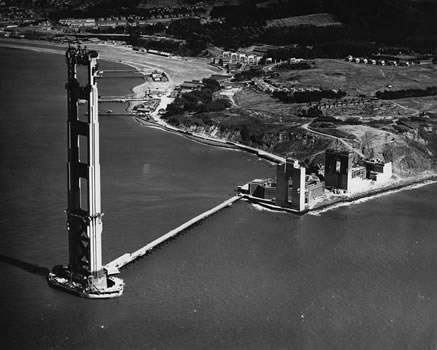
To reach the site of the south tower foundation, workers constructed a temporary roadway on a timber access trestle, or wharf, from the San Francisco shore. The dangers of the exposed location soon became apparent in 1933, when a freighter collided with the trestle. Two months later, over half of the repaired structure collapsed in a storm. Undaunted, the engineers and workers restored the structure and continued their work.
The plans called for a huge oval-shaped concrete barrier, or fender, to protect the base of the south tower from ship collisions during fog. To build the fender, workers placed the concrete through tubes underwater into wood forms, where it set.
When the fender was built up above the water level and was visible, the workers called it a “giant bathtub.” For the foundation pier, the base on which the tower would stand, workers placed concrete underwater to fill the bottom portion of the fender. After pumping out the remaining 9.4 million gallons (35.6 million liters) of seawater, workers inside the “bathtub” completed the placement of reinforcing steel and concrete.
Once the concrete work was done, the erection of the steel for the south tower began in January 1935 and was completed in just six months.
More Images
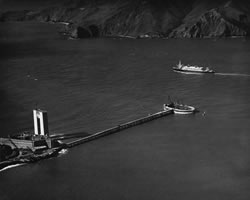 |
An access wharf extended from the San Francisco shore to the south tower.
|
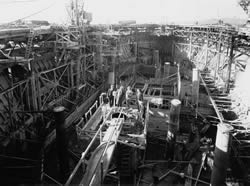 |
The foundation's reinforced concrete being built up from the bedrock of the seafloor. The vertical tubes are the inspection wells that allowed access down through the concrete.
|
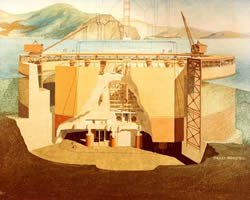 |
A cross section of the south tower fender walls and foundation. The illustration was done by Chesley Bonestell, a designer who worked on architectural details of the Chrysler Building in New York and other prominent buildings, and who later became one of the most famous illustrators of space exploration.
|
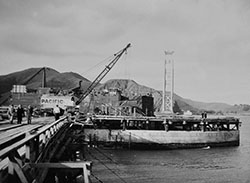 |
Fender walls under-construction around the South Tower from the Golden Gate Bridge, Highway and Transportation District - The wooden trestle bridge in the foreground was a temporary construction to provide access to the site of the South Tower. |
Explore this Topic Further
Working Underwater from the Golden Gate Bridge, Highway and Transportation District (GGBHTD) (grade 3 to adult)
Construction of the south tower could not have been completed without the help of the divers who were lowered up to 110 feet below the surface to guide materials and equipment, place explosive charges, operate hydraulic equipment, and remove detonated debris.
Underwater Construction from PBS American Experience (grade 3 to adult)
Working underwater to construct the foundations was a dangerous job. Construction workers in cumbersome diver suits and diving helmets were exposed to cold water and strong currents and could barely see in the murky water. They went down up to the seafloor, up to 110 feet deep, and had to worry about decompression sickness, also called caisson disease or the bends, if they came back up to the surface too quickly.
More photos from the Golden Gate Bridge, Highway and Transportation District (GGBHTD) (all ages)
See a few more photos of the 1,100 foot (335 meter) trestle that extended from the shore to the south tower.